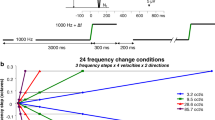Abstract
The development of auditory evoked responses as objective methods of testing hearing is discussed with attention focusing on the ‘crossed acoustic response’ (c.a.r.) in this role. The instrumentation used to facilitate the use of the c.a.r. in testing neonates and young children is described, and an outline is given on how some of the problems involved in this type of testing have been overcome.
Sommaire
L'article étudie le développement des réponses auditives évoquées en tant que méthodes objectives servant à tester l'ouïe et en s'attardant en particulier sur la ‘réponse acoustique croisée’ (r.a.c.) dans ce rôle. On décrit les instruments servant à faciliter l'usage de la r.a.c. dans les tests sur nouveauxnés et les enfants en bas âge et on ébauche la méthode permettant de surmonter quelques uns des problèmes rencontrés dans ce genre de test.
Zusammenfassung
Es wird die Entwicklung von durch das Ohr hervorgerufenen Reaktionen als objektive Verfahren zur Prüfung des Gehörs besprochen, wobei sich die Aufmerksamkeit auf die gekreuzte akustiche Reaktion (c.a.r.) in dieser Rolle konzentriert. Die zur Vereinfachung des Einsatzes von c.a.r. beim Prüfen von Neugeborenen und Kleinkindern verwendeten Instrumente werden beschrieben, und es wird umrissen, wie gewisse Probleme, die man bei dieser Prüfung antrifft, gelöst wurden.
Similar content being viewed by others
References
Appleby, S. V., McDermick, P. andScott, J. W. (1963) The sound evoked cerebral response as a test of hearing,EEG & Clin. Neurophys.,15, 1053.
Beagley, H. A. (1973)Electrocochleography in clinical otology,J. Laryng. & Otol.,87, 441.
Coles, R. R. A. (1972) Can present day audiology really help in diagnosis? An otologist's question, —ibid.,86, 191.
Davis, M., Davis, P. A., Loomis, A. L., Harvey, E. N. andHobart, G. (1939) Electrical reactions of the human brain to auditory stimulation during sleep,J. Neurophysiol.,2, 500–514.
Davis, H. andYoshie, N. (1963) Human evoked cortical responses to auditory stimuli,Physiologist,6, 164.
Dawson, G. D. (1951) A summation technique for detecting small signals in a large irregular background,J. Physiol.,115, 2P.
Dawson, G. D. (1954) A summation technique for the detection of small evoked potentials,EEG & Clin. Neurophys.,6, 65.
Douek, E. E., Gibson, W. P. R. andHumphries, K. N. (1973) The crossed acoustic response,J. Laryng. & Otol.,87, 711.
Douek, E. E., Gibson, W. P. R. andHumphries, K. N. (1974) The crossed acoustic response and objective tests of hearing,Develop. Med. Child Neurol.,16, 32–39.
Douek, E. E., Gibson, W. P. R. andHumphries, K. N. (1975) The crossed acoustic response,Revue Laryng. Bordeaux.
Eggermont, J. J. andOdenthal, D. W. (1974) Frequency selective masking in electrocochleography,ibid. Revue Laryng. Bordeaux.
Elberling, C. (1974) Action potentials along the cochlear partition recorded from the ear canal in man,Scand. Audio.,3, 13.
Geisler, C. D., Frishkopf, L. S. andRosenblith, W. A. (1958) Extracranial responses to acoustic clicks in man,Science,128, 1210.
Geisler, C. D. (1960) Average responses to clicks in man recorded by scalp electrodes. MIT Technical report 380.
Gibson, W. P. R. (1975) M.D. thesis, University of London.
Goldstein, M. H. andKiang, N. Y-S. (1958) Synchrony of neural activity in electric responses evoked by transient acoustic stimuli.J. Acoust. Soc. Am.,30, 107.
Humphries, K. N. (1975) Ph.D. thesis, University of London.
Jacobson, J. L., Cody, D. T., Lambert, E. H. andBickford, R. G. (1964) Physiological properties of the postauricular response (sonomotor) in man,Physiologist,7, 167.
Kiang, N. Y-S, Grist, A. H., French, M. A. andEdwards, A. G. (1963) Postauricular electrical response to acoustic stimuli in humans,MIT Quart. Prog. Rep.,68, 218.
Lowell, E. L. (1965) Sonomotor reflexes: myogenic evoked potentials in the young deaf child: identification and management,Acta Otolaryng. (St) Suppl.,206, 127.
Milner, B. A. (1970) The physical study of bioelectric potentials generated in response to acoustic stimuli. Ph.D. thesis, University of London.
Portmann, M., Le Bert, G. andAran, J. M. (1967) Potentiels cochléaires obtenus chez l'homme en dehors de toute intervention chirurgicale,Revue de Laryng. Otol. Rhinol.,88, 157.
Rapin, I. (1964) Evoked responses to clicks in a group of children with communication disorders,Ann. NY Acad. Sci.,112, Art. 1 182.
Rapin, I. andSchimmel, H. (1974) Auditory evoked responses for assessing auditory sensitivity in young infants and unco-operative handicapped children. Proceedings of the international symposium on cerebral evoked potentials in man, Brussels.
Sheridan, M. (1958) Simple clinical hearing tests for very young or mentally retarded children,Brit. Med. J.,2, 999.
Sheridan, M. (1964) Disorders of communication in young children.Bull. MH and PM Lab. Service,23, 20.
Spreng, M. andKeidel, W. D. (1971) Problems of simple averaging of electrophysiological recording and the use of additional methods,Rev. Laryng. Bordeaux Suppl.,92, 722–738.
Teas, D. C., Eldredge, D. H. andDavis, H. (1962) Cochlear responses to acoustic transients: an interpretation of whole-nerve action potentials,J. Acoust. Soc. Am.,34, 1438.
Tonndorf, J. (1960) Time/frequency analysis along the partition of cochlear models: a modified place concept,J. Acoust. Soc. Am.,34, 1337.
Williams, H. L., Morlock, H. C., Jun., Morlock, J. V. andLubin, A. (1964) Auditory evoked responses and the e.e.g. stages of sleep,Ann NY Acad. Sci.,112, 172.
Yoshie, N., Omashi, T. andSuzuki, T. (1967) Nonsurgical recording of auditory nerve action potentials in man,Laryng.,77, 76.
Yoshie, N. andOkudaira, T. (1969) Myogenic evoked potential responses to clicks in man,Acta Otolaryng.,252, 89.
Yoshie, N. (1973) Diagnostic significance of e.co.g. in clinical audiometry,Audiology,12, 504.
Zerlin, S. (1969) Travelling-wave velocity in the human cochlea.J. Acoust. Soc. Am.,46, 1011.
Zwicker, E. andFastl, H. (1972) On the development of the critical band, —ibid.,52, 699.
Author information
Authors and Affiliations
Rights and permissions
About this article
Cite this article
Humphries, K.N., Gibson, W.P.R. & Douek, E.E. Objective methods of hearing assessment: A system for recording the crossed acoustic response. Med. & biol. Engng. 14, 1–7 (1976). https://doi.org/10.1007/BF02477082
Received:
Accepted:
Issue Date:
DOI: https://doi.org/10.1007/BF02477082




